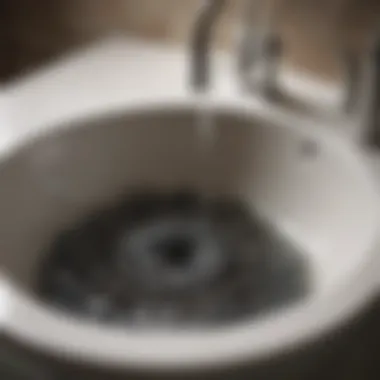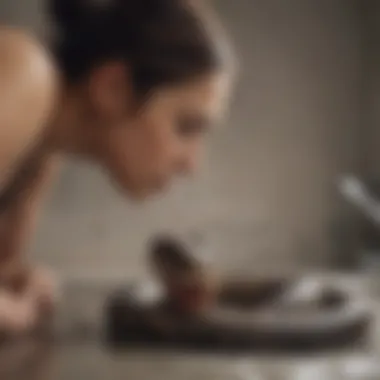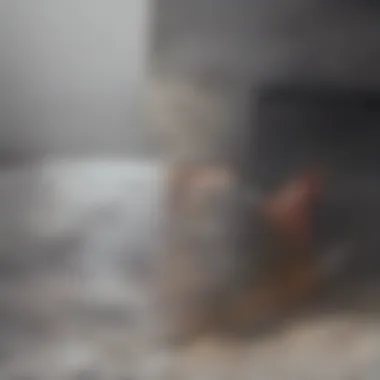Top Techniques for Hair Removal from Drains


Intro
Clogged drains, particularly those impacted by hair accumulation, pose a persistent challenge for many homeowners. The accumulation of hair not only disrupts the functionality of drainage systems but can also lead to more severe plumbing issues if not addressed promptly. Understanding effective methods for tackling this issue becomes essential. This guide will explore various techniques and tools designed to maintain the efficiency of drains and prevent potential blockages.
Homeowners often face these challenges with limited knowledge on how to approach them. Ignoring the problem can lead to costly plumbing repairs or damages in surrounding areas. Thus, this article serves as a comprehensive resource that highlights practical methods, preventive measures, and tools necessary for keeping home drainage systems in optimal condition.
In exploring these methods, readers can choose from do-it-yourself solutions as well as professional assistance. Each approach will cater to different needs and preferences, allowing for informed decisions that suit individual circumstances.
Understanding the Issue of Hair in Drains
Hair accumulation in drains is a significant concern for many homeowners. It is often an overlooked issue but can lead to substantial problems. Clogged drains create not only inconveniences but also potential health hazards. Water flow can become restricted, leading to stagnant water which can attract insects and cause unpleasant odors. Understanding why hair clogs drains and the implications can empower homeowners to prevent serious plumbing issues.
Common Causes of Hair Accumulation
Several factors contribute to hair buildup in drains. The most apparent cause is shedding. Each day, individuals can lose between 50 to 100 strands of hair, and this adds up over time. In bathrooms, hair can easily wash away during a shower and collect at the drain. Additionally, the use of products such as conditioners can make hair more slippery, causing it to clump and create blockages.
Other causes include:
- Poor Drain Gradient: A drain that is not adequately sloped can make it easier for hair to become stuck.
- Age of Plumbing: Older plumbing systems may have rough interiors which catch hair more easily.
- Build-up of Other Debris: Hair can combine with soap scum, food particles, and dirt, leading to more severe clogs.
The Impact of Clogged Drains
Clogged drains have immediate and long-term impacts on households. Initially, a slow-draining sink or shower seems relatively harmless, but it can escalate quickly. Water can back up, leading to spills and water pressure changes that may cause further plumbing issues.
Moreover, frequent clogs can multiply, making each subsequent instance more difficult to clear. This can lead homeowners to resort to chemical cleaners, which may damage pipes over time.
"The prevention of hair accumulation in drains is not just about maintaining drainage efficiency; it is about safeguarding your plumbing system's integrity."
The costs associated with drain repairs and professional plumbing services can be significant. Understanding the relationship between hair and drain health is essential for effective home maintenance. By grasping these elements, homeowners can take proactive measures to mitigate hair-related issues, ensuring their drainage systems remain functional and efficient.
Preventative Measures to Avoid Clogs
Hair accumulation can lead to troublesome clogs in drainage systems. Therefore, implementing preventative measures is not just beneficial, it is essential for maintaining functional plumbing. By being proactive, homeowners can mitigate the risks and costs associated with plumbing emergencies. These measures can save time and promote overall household efficiency.
Best Practices for Managing Hair
Managing hair effectively is the first step in preventing drain clogs. Here are some best practices to consider:
- Routine Cleaning: Regularly clean shower and sink traps to remove hair before it can build up.
- Hair Removal Tools: Use a drain hair catcher or sieve. These can trap hair and other debris before they enter the plumbing system.
- Educate Family Members: Encourage everyone in the household to brush their hair in areas away from drains. Simple awareness can significantly reduce hair getting into the drains.
By establishing these practices, hair accumulation can be minimized and the burden on plumbing will lessen.
Installing Drain Covers


Installing drain covers offers a physical barrier against hair and debris. This simple adjustment can have a profound effect on maintaining clear drains. Consider the following:
- Types of Covers: There is a variety of drain covers available, from simple mesh screens to more elaborate designs that trap other debris.
- Ease of Use: Ensure that the covers are easy to remove and clean. Regular maintenance of these covers will prevent the buildup of hair.
Using drain covers is an effective preventative measure; they can save homeowners from frequent and often costly plumbing services.
Regular Maintenance Routines
A consistent maintenance routine is vital in promoting drain health. This approach can lead to long-term benefits:
- Scheduled Checks: Set a specific interval for checking and cleaning drains, perhaps monthly. Timely interventions can prevent serious blockages.
- Hot Water Flush: Routinely flush drains with hot water. This can help dissolve grease or soap that may attract hair and aid in keeping the plumbing clear.
- Professional Inspection: Occasionally, having professionals inspect the plumbing system can catch potential issues early.
DIY Solutions for Hair Removal
The accumulation of hair in drains is not just a nuisance; it highlights the necessity of knowing effective DIY solutions for hair removal. Many homeowners prefer these methods due to their cost-effectiveness, simplicity, and the ability to address the problem quickly without calling for professional help. By exploring various techniques, individuals can gain a deeper understanding of how to prevent and resolve hair-related clogs efficiently. DIY solutions empower homeowners with practical knowledge, allowing them to maintain their plumbing systems with confidence and ease.
Using a Plumber's Snake
A plumber's snake is a powerful tool that can clear stubborn clogs caused by hair. It consists of a long, flexible metal cable with a spiral end designed to latch onto hair and debris. Using this tool requires some skill, but it can be highly effective. The main benefit is its ability to reach deep into pipes where clogs often sit. When using a plumber's snake, it is crucial to insert it gently into the drain, turning the handle as you push forward. This method manages to loosen the blockages without damaging the pipes. Homeowners should consider having a plumber's snake on hand for emergencies, as it can save time and cost over calling a professional.
Creating a Homemade Drain Cleaner
Homemade drain cleaners are an eco-friendly alternative to store-bought chemical products. They can effectively clear hair and debris without harsh chemicals.
Combining Baking Soda and Vinegar
Combining baking soda and vinegar is a well-known method for drain cleaning. This reaction produces carbon dioxide bubbles that can help dislodge hair clogs. The key characteristic of this combination is its safety; it is safe for both the environment and the pipes. To use it, pour half a cup of baking soda followed by half a cup of vinegar down the affected drain. Afterward, let the mixture sit for at least 30 minutes before flushing with hot water.
This method is popular because it utilizes common household items, making it accessible for most homeowners.
The advantages of this technique include its cost-effectiveness and environmental friendliness. However, one drawback is that it may not be powerful enough for severe clogs.
Using Hot Water
Using hot water is a straightforward method that can also help in drain maintenance. It works by softening grease and hair, allowing them to break free from the drain walls. The key element here is the heat; it helps melt the hair and soap residues that may be causing a blockage. Pouring boiling water down the drain can be beneficial after using the baking soda and vinegar method or as a standalone solution.
This approach is advantageous because it is simple and involves no harmful chemicals. Still, it may not be sufficient for clogs that are particularly stubborn or deep within the plumbing system.
Employing a Wet/Dry Vacuum
A wet/dry vacuum can be an effective ally in the fight against hair clogs. This tool provides strong suction that can pull hair and debris out of the drain. Simply place the vacuum hose over the drain and switch it on. It’s crucial to set the vacuum for liquid before proceeding. A wet/dry vacuum is particularly useful for larger accumulations and can also help with flooding issues in other contexts.
Using a Coat Hanger for Physical Removal


For those who prefer hands-on techniques, a coat hanger can be repurposed to remove hair. By straightening the hanger and creating a small hook at one end, you can reach into the drain and fish out hair. This method requires patience and might take several attempts, but it is effective for removing visible clogs. Additionally, it is a very low-cost solution, appealing to many homeowners.
Regular Flush with Hot Water
Regularly flushing drains with hot water can prevent hair build-up before it becomes an issue. This practice can be integrated into a home maintenance schedule. Flushing hot water weekly creates a routine that helps keep drains clear. It's an easy step that requires minimal effort and can effectively assist in maintaining overall drain health.
Chemical Solutions for Drain Cleaning
Chemical solutions offer a quick and effective means for tackling hair-related drain issues. While conventional methods like plungers or manual tools can be effective, chemicals often provide a different option for speeding up the cleaning process. With the right chemical drain cleaner, homeowners can dissolve stubborn clogs with minimal effort. However, there are important aspects to consider when opting for chemical solutions, including safety, environmental impact, and the types of clog encountered.
Chemical cleaners can be especially useful in homes where hair accumulations in drains are common. They target the chemical structure of hair and other organic debris, breaking it down in a matter of minutes. Moreover, appropriate usage of these products can lead to cleaner drain systems, reducing the frequency of blockages and maintenance requirements.
Types of Chemical Drain Cleaners
Several types of chemical drain cleaners exist, each with its specific function and composition. Understanding these options is crucial for effective clog removal:
- Caustic Cleaners: These are basic solutions, often containing sodium hydroxide. They work by producing heat to break down organic matter, including hair. Suitable for greasy clogs but can be damaging to pipes if overused.
- Acidic Cleaners: Containing hydrochloric acid, these cleaners can break apart various substances. They are effective for heavy buildup but should be used with extreme caution due to their corrosive properties.
- Oxidizing Cleaners: These cleaners, usually containing bleach or peroxides, remove organic matter through oxidation. They're effective but may not work well on tough clogs.
- Enzyme Cleaners: Utilizing natural enzymes, these products digest hair and organic debris over time. They are more environmentally friendly but may take longer to see results.
Regardless of the type, ensuring that the chemical nature aligns with the clog type is essential for optimal results.
Safeguards When Using Chemicals
Using chemical drain cleaners requires careful attention to safety protocols. Here are some safeguard practices:
- Read Instructions: Always follow the manufacturer’s guidelines for safe usage.
- Protective Gear: Wear gloves and goggles to prevent skin and eye contact with harmful substances.
- Ventilation: Ensure the area is well-ventilated while using these chemicals to avoid inhaling fumes.
- Storage: Keep all chemicals out of reach of children and pets, as ingestion can be hazardous.
- Avoid Mixing: Never mix different cleaning products, especially acidic and caustic cleaners, as dangerous reactions may occur.
Using chemical solutions can be effective, offering homeowners a powerful tool against clogged drains. However, applying these products with diligence and care is pivotal for both safety and effectiveness.
When to Consider Professional Help
Knowing when to seek professional assistance for drain issues is crucial for effective maintenance and resolution of plumbing concerns. While DIY methods can be effective for minor hair clogs, certain situations require the expertise of a trained plumber. Ignoring these signs can lead to more severe problems, including significant water damage and costly repairs.
Signs You Need a Plumber
It is essential to recognize the symptoms indicating that a hired professional is necessary. Common signs include:
- Persistent Clogs: If you find that a drain continues to clog even after multiple attempts to clear it, this can signal a deeper issue.
- Slow Drainage: When water drains at an unusually slow pace, it may suggest a significant obstruction further down the system.
- Unpleasant Odors: Foul smells from the drain could indicate a buildup of organic matter or a failed system.
- Multiple Clogs: If several drains are experiencing problems simultaneously, it is likely an indication of a systemic issue.
- Gurgling Noises: Strange sounds during drainage can suggest issues with venting in the plumbing system, which often calls for an expert.
Addressing such symptoms early can prevent further complications, making awareness imperative.
Costs Associated with Professional Services
Understanding the potential costs involved in hiring a plumber allows homeowners to budget accordingly. Factors affecting these costs include:


- Type of Service Required: Basic drainage services may be less expensive than more complex plumbing interventions.
- Location: Reputable plumbers may base their fees on geographic factors, which can influence pricing.
- Company Reputation: Established businesses often charge a premium for their experience and guarantee of quality.
On average, homeowners should expect to pay between $150 and $500 for plumbing services, depending on the specifics of the job.
- Emergency Calls: After-hours services or weekend requests generally come at a higher rate, reflecting the urgent nature of the response.
Investing in professional help can be prudent in the long run, minimizing the risk of overwhelming damage or costly repairs that may arise from neglecting plumbing issues.
Choosing the Right Tools
Choosing the right tools is fundamental to effectively manage hair removal from drains. A well-selected tool can significantly minimize the time and effort needed to clear hair clogs. Additionally, having the right equipment can reduce the risk of damaging your plumbing system. It is essential to consider both the type of clog and the tools available. Not all tools will work effectively in every scenario.
Investing in quality tools may seem costlier initially, but it often pays off in the long run. Durable and efficient tools can lead to a more thorough job, which decreases the likelihood of recurring clogs. In this part, we will look closer at essential drain cleaning tools and how to evaluate their effectiveness.
Essential Drain Cleaning Tools
Several tools are indispensable for tackling hair issues in drains. Here are some noteworthy ones:
- Plumber's Snake: This is a long, flexible tool that can penetrate deep into the pipes, helping to break apart clogs and remove hair that may be lodged further down the drain.
- Drain Auger: Similar to a plumber's snake but typically more powerful. An auger can navigate multiple bends in pipes and dislodge more stubborn clogs.
- Wet/Dry Vacuum: A versatile tool that can be used to suck out hair from drains. It is especially useful for large amounts of debris.
- Chemical Drain Cleaners: While not always recommended due to potential negative effects on pipes, they can be effective for certain types of clogs. Use with caution.
- Drain Covers: While not tools in the traditional sense, they are preventive measures. Covers catch hair before it can enter the drain, thereby reducing the need for clean-ups.
When selecting these tools, consider the specific conditions in your home. For example, older pipes may require gentler tools to avoid damage.
Evaluating the Effectiveness of Various Tools
To assess how effective your drain cleaning tools are, think about the following:
- Success Rate: How often does a tool work on first attempt? For instance, if the plumber's snake rarely fails, it is likely effective.
- Ease of Use: A great tool is one that anyone can operate without needing extensive training. If a tool is overly complicated, it may lead to frustration and reduced effectiveness.
- Durability: A tool should be able to withstand regular use without breaking. Investing in sturdy tools is often more satisfactory.
- User Reviews: Online reviews can provide insight into the effectiveness of specific products. Websites like Reddit offer discussions where users share their experiences with different tools.
Final Thoughts on Drain Maintenance
Maintaining clear and efficient drains is crucial for any homeowner. It not only prevents unpleasant odors and situations but also avoids costly plumbing repairs in the long run. The methods discussed throughout this article offer many effective solutions for hair removal and overall drain care. Implementing these techniques will help create a smoother experience in home maintenance.
Establishing a Regular Cleaning Schedule
Setting up a regular cleaning schedule is vital for effective drain maintenance. Establishing a routine can greatly reduce the chances of hair buildup. Homeowners should determine a cleaning frequency based on personal usage. For example, households with long-haired individuals may need to clean drains more often.
A consistent schedule might include the following steps:
- Weekly inspections: Check drain covers and clean them as necessary.
- Monthly deep cleaning: Use a proper tool or a DIY solution to clear any emerging clogs.
- Seasonal assessments: Consider professional services for a thorough drain inspection at least twice a year.
This proactive approach will reduce emergencies and allow for easier management of drain health.
Educating Household Members on Proper Use
It's not just about the tools and techniques. Educating everyone in the household about proper drain usage is equally important. Clear communication can help prevent clogs before they occur. Household members should be advised against disposing of hair, grease, and other non-degradable objects down the drain. Simple habits, such as:
- Using drains only for appropriate waste - Encourage the use of trash bins for hair and other restroom waste.
- Checking hair before showering - A quick comb-out can prevent excessive hair loss into the drain.
- Explaining the consequences of neglect - Understanding how clogged drains disrupt home life can motivate change.
By making sure that everyone understands their role in maintaining drains, you can foster a shared responsibility towards a well-functioning household. With education and planned cleaning schedules, homeowners can enjoy efficient drains and peace of mind.







